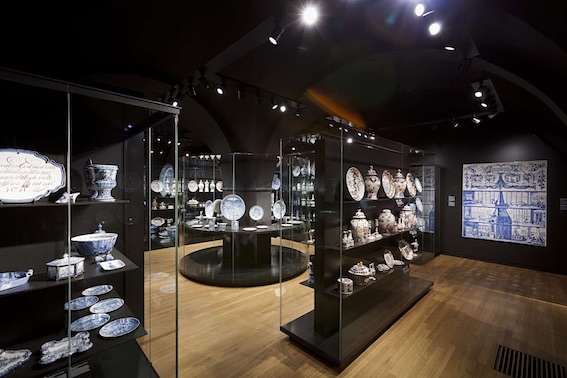
Collecting Delftware
Dutch Delftware played a pivotal role in the development of European ceramics in the seventeenth and eighteenth centuries. The robust faience center of Delft was the result of two important currents of the time: the Italian production of majolica and the Chinese and Japanese wares that were imported by the Dutch East India Company (VOC). Through the influence of Queen Mary, the taste for painted Delftware spread rapidly through a wealthy European elite. Because of its remarkable diversity of shapes, the delicacy of the decoration and the gaiety of its colors, Dutch Delftware became the source of inspiration for many ceramic centers throughout Europe, which endeavored to work in the Delft style.
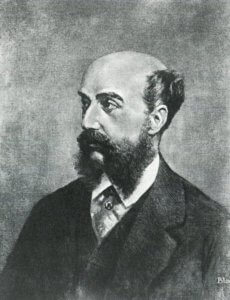
Despite its predominant role in the history of European ceramics, Dutch Delftware only became a serious source of interest from art historians and collectors in the second half of the nineteenth century, a period that rehabilitated the decorative arts, and particularly ceramics. Delftware was assembled, classified and studied, and finally given its honorable recognition alongside seventeenth and eighteenth century European ceramics. Many of the terminology used to describe Delftware were coined during the nineteenth century, such as cashmere, a term inspired by the woolen shawls that were imported at the time.
The nineteenth century also bore witness to a renewed interest in Orientalism. With the European colonial expansion, a strong intellectual, artistic and scientific interest for the Orient, including China and Japan emerged, especially in the field of art. Many Delftware objects reflect the fantasized view that the Dutch had about China and Japan. It is then no surprise that the Golden Age of Dutch Delftware became the center of intellectual attention in the centuries that followed.
The first nineteenth-century connoisseurs of Delftware came from France. Albert Jacquemart (1808-1875) was a renowned art historian who specialized in ceramics. In his text, Histoire de la Céramique, he recounted his visit to the Low Countries in 1852, where he was surprised by its lack of faience: “The name of Delft pronounced by us provoked more astonishment than enthusiasm.” The only object that he could find in the Royal Cabinet of Curiosities in The Hague was a beautiful plaque, probably painted by the famous Frederik van Frijtom, which was ironically catalogued as porcelain instead of Delftware.[1]
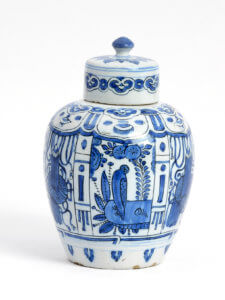
One of the first collectors of Delftware was the Frenchman Charles Antoine Edouard, Baron de la Villestreux. At thirty years old, he was appointed as second secretary at the French Embassy in The Hague. Perhaps he was captivated by the beautiful display of Delftware presented during the Delft likely attended because exhibition of 1863, which he had lent a brass chandelier for display. While Delftware was barely included in prior exhibitions, there were over one hundred pieces on view in 1863. Edouard quickly amassed a large collection over 250 pieces. In 1869, he was appointed as a secretary in Florence ‘de la Légation de l’empereur à Florence’ and sold most of his collection to John F. Loudon, the son of a Scottish naval officer from the VOC who had made a fortune out of sugar and indigo. When Loudon retired in 1867, he spent the next decade assembling one of the most beautiful collections of Delftware totaling more than 450 pieces.[2]
Loudon’s large collection of Delftware was the subject of a catalogue written by Henri Havard in 1877. In the introduction, Havard explains Loudon’s passion for collecting, which propelled him to purchase any beautiful piece no matter the cost. According to Havard, his collection was undeniably “the most complete, the richest in large pieces, and the most abundant in rare objects of all (the collections) that exist.”[3]
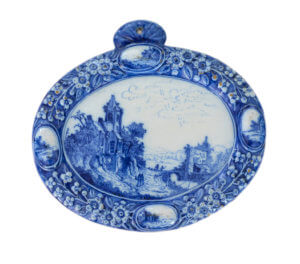
In 1878, Havard published a scientific book entirely dedicated to Dutch Delftware. The book was the result of over ten years spent among “the principal collections of Europe… (assembling)… those ceramics documents which would serve him as a starting point,” and five years of archival research “to rejoin the repeatedly broken threads of this difficult study.”[4] The archives revealed the connection between many marks and their factory owners. Even today, Havard’s extensive research constitutes the basis for the study of Delftware. The work of Havard paved the way for further research, with other Delftware books published in French, English and Dutch. Following this, museums began to build collections of Delftware in the first quarter of the twentieth century. For example, in 1911, the famous collection of Albert Evenepoel was bequeathed to the Musées royaux d’Art et d’Histoire in Brussels. After Loudon’s death in 1919, his heirs donated the majority of his collection to the Rijksmuseum in Amsterdam. The original collection is exhibited today in several rooms along with additional pieces that were later acquired by the museum.
The published books and Delftware museum collections reveal the taste of contemporary collectors. The general preference of collectors during the late nineteenth century was for the polychrome pieces rather than the blue and white objects, and also the unusual and exotic decorative objects. Also, as it was implicitly recommended by the merchant Auguste Demmin in Guide de l’amateur de faïences et porcelaines, the marked pieces were highly sought-after.[5]
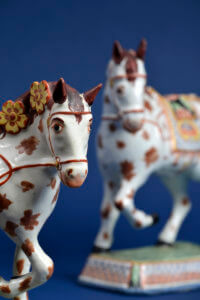
A third generation of collectors asserted even more refined tastes. The newly discovered diversity of Delftware urged collectors to specialize in one field. For example, the collectors Maurice de Ramaix (1850-1918), a Belgian politician and his son Gaston built a collection of mostly blue and white pieces from the seventeenth and eighteenth centuries. De Ramaix was a diplomatic attaché in Paris, Constantinople, Vienna, Berlin, The Hague and Persia. Afterward, he returned to Belgium where he became a senator and a member of the Parliament. In 1894, he bought and restored a castle in Grune, Belgium. After his death, De Ramaix’s collection was passed to his eldest son, Gaston (1878-1937), who was also a diplomat. Gaston had a predilection for the Dutch Golden Age and completed his father’s collection. He showcased the remarkable assemblage of Delftware in his seventeenth-century castle surrounded by Dutch paintings and prints from the same era.
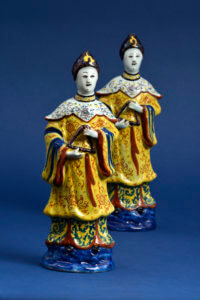
After World War II, increasing numbers of antique dealers bought and sold Delftware to an eager clientele who viewed the ceramic history of Delft as a source of national pride. For example Mr. H.C. Bout, of who we are honored to present the collection, who as a child by visiting the antique shop of Mrs. Maquestiay did his first step in the world of Delftware. The antique shop, which was later run by Mrs. Maquestiay’s son in law, Mr. Van Kwikkelberge was comprised of beautiful Delftware animal figures made during the eighteenth century. As a child, Mr. Bout was amazed by the display of beautiful polychrome figures and eventually acquired an extensive knowledge about eighteenth-century Delftware. In the 1970’s, Mr. Bout made his first important acquisition of a pair of cows. With his wife, the two formed a superb collection of Delftware, mostly comprised of eighteenth-century rond de bosse figures.
As we saw, “Collecting is about reconquest of the past, organization of the present and transport toward the future.”[6] The objects tell countless stories of the makers, its context of production, the history of technology and the owners of the objects. Each carefully amassed collection is a reflection of its owner, who creates knowledge by assumptions, juxtapositions, findings and associations. Thus, the collector is connected to a myriad of civilisations and assumes a responsibility to preserve history.
[1] A. Jacquemart, Histoire de la céramique : étude descriptive et raisonnée des poteries de tous les temps et de tous les peuples, Paris 1873, p. 546
[2] J.D. van Dam, “Van onbekend en onbemind tot zeer gezocht en peperduur: Delftse faience in de negentiende eeuw”, in Vormen uit vuur, 1992, no. 145, pp. 4-13
[3] H. Havard, Catalogue chronologique et raisonné des faïences de Delft composant la collection de Mr John F. Loudon, The Hague 1877, pp. 6-7
[4] H. Havard, Histoire de la faïence de Delft, Paris/ Amsterdam 1878, p. I-II.
[5] A. Demmin, Guide de l’amateur de faïences et porcelaines : poteries, terres cuites, peintures sur lave, émaux, pierres précieuses arti cielles, vitraux et verreries, Paris, 1867
[6] A.S. Weiss, The Grain of the Clay: Reflections on Ceramics and the Art of Collecting, London 2016, p. 23



